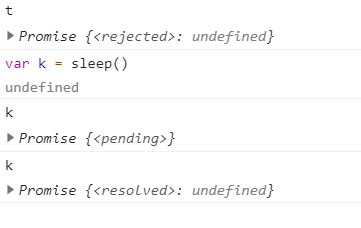看完这篇文章,你将了解:
- promise 有几种状态
- +[] 为何等于 0
- setTimeout 为何不算 JS 的全局函数
- 解决 this 的一个疑点
- max 函数
- 若干情形下的 undefined
promise 有几种状态?
promise 有三种状态: pending/resolve/reject。如下
function sleep() {
return new Promise((resolve, reject) => {
setTimeout(() => {
if(Math.random() < .5) {
resolve()
} else {
reject()
}
}, 2000)
})
}
var t = sleep()
console.log(t)
+[] 为何等于 0?
这个涉及的东西比较绕,搜了一下,stackoverflow 上有一位老哥总结得很详细。所以直接引用他的答案
Specification details for +[]:
This is quite a maze, but to do +[], first it is being converted to a string because that's what +says:
11.4.6 Unary + Operator
The unary + operator converts its operand to Number type.
The production UnaryExpression : + UnaryExpression is evaluated as follows:
- Let expr be the result of evaluating UnaryExpression.
- Return ToNumber(GetValue(expr)).
ToNumber() says:
Object
Apply the following steps:
- Let primValue be ToPrimitive(input argument, hint String).
- Return ToString(primValue).
ToPrimitive() says:
Object
Return a default value for the Object. The default value of an object is retrieved by calling the [[DefaultValue]] internal method of the object, passing the optional hint PreferredType. The behaviour of the [[DefaultValue]] internal method is defined by this specification for all native ECMAScript objects in 8.12.8.
[[DefaultValue]] says:
8.12.8 [[DefaultValue]] (hint)
When the [[DefaultValue]] internal method of O is called with hint String, the following steps are taken:
- Let toString be the result of calling the [[Get]] internal method of object O with argument "toString".
- If IsCallable(toString) is true then,
- Let str be the result of calling the [[Call]] internal method of toString, with O as the this value and an empty argument list.
- If str is a primitive value, return str.
The .toString of an array says:
15.4.4.2 Array.prototype.toString ( )
When the toString method is called, the following steps are taken:
- Let array be the result of calling ToObject on the this value.
- Let func be the result of calling the [[Get]] internal method of array with argument "join".
- If IsCallable(func) is false, then let func be the standard built-in method Object.prototype.toString (15.2.4.2).
- Return the result of calling the [[Call]] internal method of func providing array as the this value and an empty arguments list.
So +[] comes down to +"", because [].join() === "".
Again, the + is defined as:
11.4.6 Unary + Operator
The unary + operator converts its operand to Number type.
The production UnaryExpression : + UnaryExpression is evaluated as follows:
- Let expr be the result of evaluating UnaryExpression.
- Return ToNumber(GetValue(expr)).
ToNumber is defined for "" as:
The MV of StringNumericLiteral ::: [empty] is 0.
So +"" === 0, and thus +[] === 0.
setTimeout 为何不算 JS 的全局函数
首先明确一点:
浏览器端的JavaScript包含ECMAScript,DOM对象以及BOM对象。
setTimeout 属于 BOM 对象,而我们说的 JS 全局函数若不在浏览器环境下一般指的是 ECMAScript
解决 this 的一个疑点
先看代码
var obj ={
a:1,
b:function () {
alert(this.a)
}
};
obj.b(); // 输出什么
var fun =obj.b;
fun(); // 输出什么我们都知道,对象调用自己的成员函数时,成员函数内部的 this 会指向调用它的对象
上面的代码令人困惑的是,如果我把成员函数的引用交给其他对象,再由其他对象调用这个函数时,this 的归属。
打印结果,第一次输出 1 (意料之中),第二次输出 undefined。据此,可以确定成员函数里 this 的归属,最终是由实际调用它的那一行语句中决定的。
因此: this 指向调用它的对象 !== 定义它的对象
更进一步,可以继续上面代码
var c = {a: 10}
c.b = obj.b
c.b()
// 输出 10怎样,这下明白了吧
max 函数
有一个问题
var a = [1,4,5,2,9];
求a中最大值
首先
- Math 对象有 max 方法,数组对象没有 max 方法
然后
- Math.max 的语法是 Math.max(number1, number2, number3, ...)
所以,数组既不能直接调用 max 方法,也不能直接传给 Math 对象的 max 方法去调用
好在我们有 apply,允许用数组的方式传入参数列表
Math.max.apply(undefined, a)搞定
若干情形下的 undefined
函数,js 的函数总要返回些什么,如果我们没写返回语句,他就自作主张返回 undefined
console.log(1) // 1 // undefined声明语句,所有的声明语句都要返回 undefined
var a = 1 // undefined b = a // 1立即执行函数
(function() {})() // undefined !(function() {})() // true
金句
- promise 有三种状态
- 浏览器端的JavaScript包含ECMAScript,DOM对象以及BOM对象
- this 指向调用它的对象 !== 定义它的对象
- 数组既不能直接调用 max 方法,也不能直接传给 Math 对象的 max 方法去调用
暂无评论